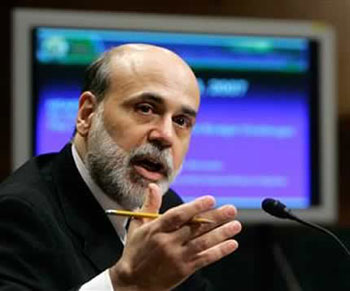 Fed Chair Ben Bernanke’s observations on monetary policy and the housing bubble have received a lot of attention. Like many other commentators (e.g., Arnold Kling, Paul Krugman, and Free Exchange), I agree with Bernanke’s conclusions, but only up to a point.
Fed Chair Ben Bernanke’s observations on monetary policy and the housing bubble have received a lot of attention. Like many other commentators (e.g., Arnold Kling, Paul Krugman, and Free Exchange), I agree with Bernanke’s conclusions, but only up to a point.
Bernanke was responding in part to the suggestion by John Taylor and others that much of the blame for the housing bubble might be placed on excessively low interest rates between 2003 and 2005. Bernanke argues that the particular numbers one uses for parameters of a Taylor Rule and measures of the inflation rate and output gap are subject to alternative interpretation, making the proposition that the interest rate was too low over this period much less clear-cut than Taylor’s writings might seem to suggest. Bernanke concludes that the problems in mortgage lending resulted primarily from inadequate regulation rather than from Greenspan having picked the wrong value for the fed funds rate.
I certainly agree with Bernanke that institutional problems were a more important factor than the level of the fed funds rate. However, it would be very hard to argue that the Fed’s targeted interest rate made no contribution. Bernanke frames most of his discussion in terms of the aggregate inflation rate and aggregate level of output, with the purpose of the Fed’s targeted interest rate taken to be achieving a desired outcome for those objectives. But I would suggest that monetary policy does not have the ability to move all industries and all prices uniformly together. By keeping interest rates low, the Fed doesn’t boost all activities, but instead preferentially stimulates particular sectors, housing investment being perhaps the single most important example.
The question we should be asking is then the following. Suppose we believe that in 2004 (a) aggregate output was below potential output (as a result of the slow recovery from the 2001 recession), and (b) house prices and residential investment were unsustainably high (as a result of the agreed-upon lax regulatory structure). Does it follow that the optimal policy should have been to use low interest rates to stimulate housing further in the hopes of making progress with goal (a)?
My answer is no. At least with the benefit of hindsight, I would have thought we could agree that the low interest rate targets of 2003-2005 were a mistake, because more stimulus to housing was the last thing the economy needed. This is not to deny that higher resource utilization rates were a possibility at the time. But I see this as one more illustration, to add to a long string of earlier historical examples, that it is possible to ask too much of monetary policy. Even if the unemployment rate is above where you want it to be and above where you expect it eventually to go, trying to bring it down faster by keeping the monetary gas pedal all the way to the floor can sometimes create bigger problems down the road.
Problems so big that they may make the demons you were trying to fight with that 1% interest rate in 2004 look pretty mild by comparison.
- Bulenox: Get 45% to 91% OFF ... Use Discount Code: UNO
- Risk Our Money Not Yours | Get 50% to 90% OFF ... Use Discount Code: MMBVBKSM
Disclaimer: This page contains affiliate links. If you choose to make a purchase after clicking a link, we may receive a commission at no additional cost to you. Thank you for your support!



Leave a Reply